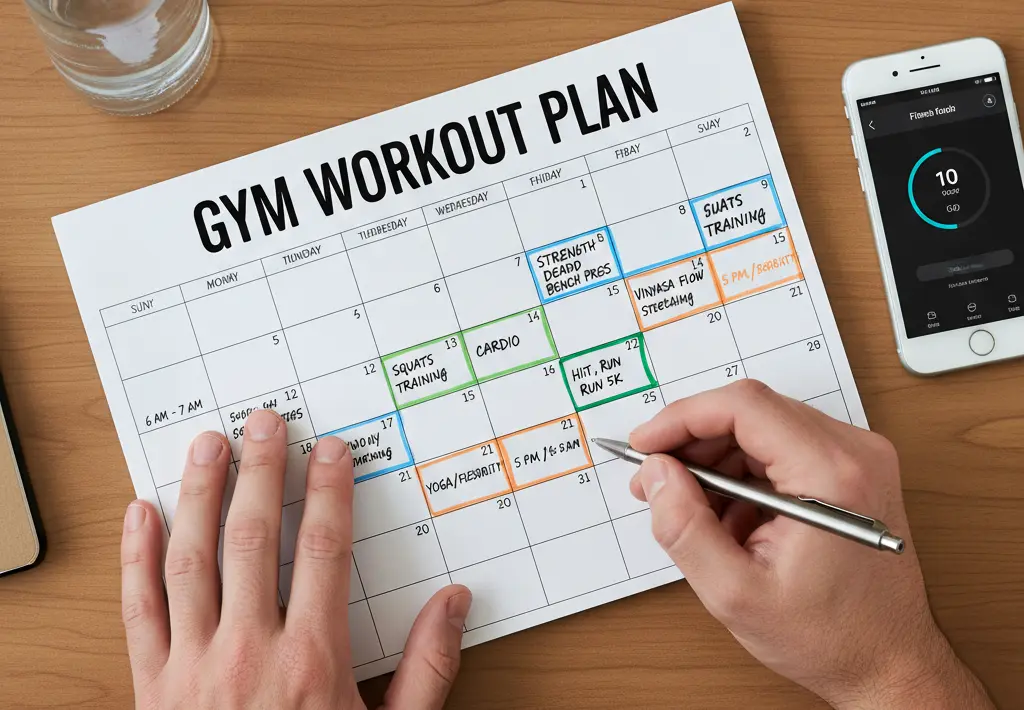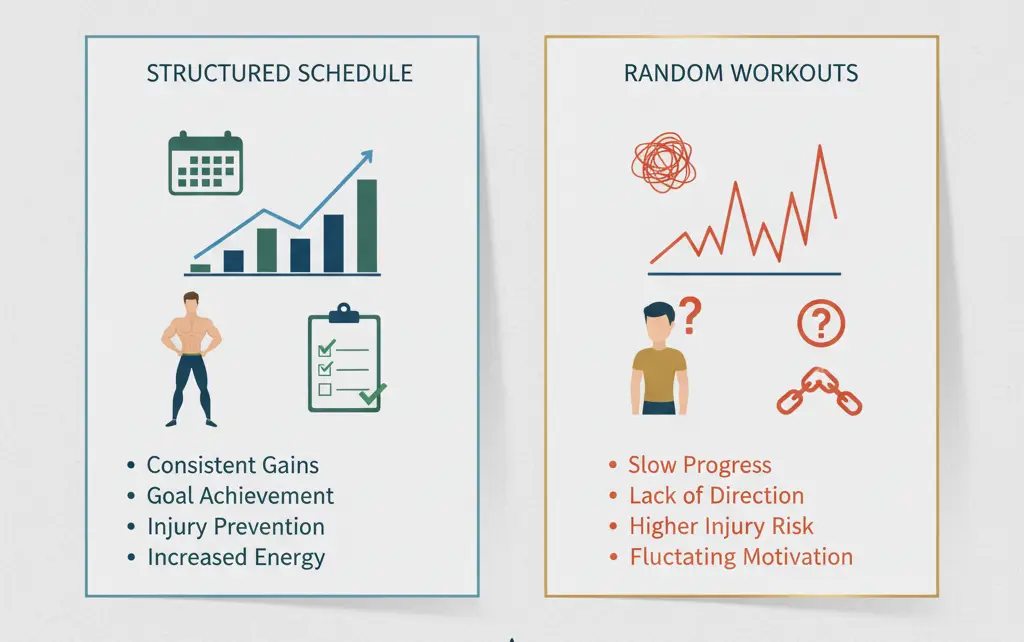What is a Gym Time Table?
A gym time table is a structured weekly schedule that outlines when and what type of workouts you’ll perform. Think of it as your personal fitness roadmap that helps you stay organized, consistent, and focused on your goals.

A well-designed gym time table includes:
- Specific workout days and rest days
- Type of exercise for each session (strength, cardio, flexibility)
- Muscle groups to target
- Duration of each workout
- Time of day you’ll train
Whether you’re training at gyms in Banjara Hills or any fitness gym in Hyderabad, having a time table ensures you’re making the most of your membership.
Why You Need a Structured Workout Schedule
Planning your gym time table isn’t just about organization—it’s about maximizing results. Here’s why a structured schedule matters:

1. Ensures Balanced Training
A proper time table prevents you from overworking certain muscle groups while neglecting others. You’ll hit all major muscle groups throughout the week.
2. Prevents Overtraining and Injury
Rest days built into your schedule allow muscles to recover and grow stronger. Without planned recovery, you risk burnout and injury.
3. Builds Consistency
Having set workout days creates a habit. When exercise becomes part of your routine, you’re 42% more likely to stick with it long-term.
4. Tracks Progress Better
A structured schedule lets you monitor improvements week by week. You’ll know exactly what you did last week and can aim to do better.
5. Optimizes Time Management
Knowing when you’ll work out helps you plan around work, family, and social commitments. No more “I’ll go when I have time” excuses.
Pro Tip: If you’re just starting out, check out our Complete Beginner’s Guide to Getting Started for foundational knowledge.
Best Times to Work Out Based on Your Goals
The best time to work out depends on your goals, schedule, and body’s natural rhythms. Here’s what research tells us:
Morning Workouts (6 AM – 10 AM)
Best for: Weight loss, building consistency, busy schedules
Benefits:
- Burns more fat on empty stomach (fasted cardio)
- Boosts metabolism for the day
- Gyms are less crowded
- Sets positive tone for the day
- Less likely to skip due to “life getting in the way”
Challenges:
- Need time to warm up properly
- Strength may be slightly lower
- Requires early wake-up
Many gyms in Hyderabad open as early as 5:30 AM to accommodate morning warriors.
Afternoon Workouts (12 PM – 4 PM)
Best for: Flexibility training, moderate intensity workouts
Benefits:
- Body temperature is optimal
- Good compromise between morning and evening
- Can break up work day
- Better flexibility than morning
Challenges:
- Work commitments may interfere
- Peak crowd at some gyms
- May feel sluggish after lunch
Evening Workouts (5 PM – 9 PM)
Best for: Strength training, muscle building, maximum performance
Benefits:
- Peak muscle strength (up to 6% stronger than morning)
- Best reaction time and endurance
- Body temperature at highest
- Ideal for progressive overload
- Can de-stress after work
Challenges:
- Gyms are most crowded (5-7 PM rush)
- May interfere with sleep if too late
- More excuses to skip after long day
Local Insight: Best gym in Hyderabad locations typically see peak crowds between 6-8 PM on weekdays.
The Verdict
The best time to work out is whenever you can be most consistent. While evening may be optimal for performance, if you always skip evening workouts, then morning is better for YOU.
Creating Your Weekly Gym Time Table
Follow these steps to build a personalized gym schedule that fits your lifestyle:
Step 1: Determine Your Weekly Training Frequency
Beginners: 3-4 days per week Intermediate: 4-5 days per week Advanced: 5-6 days per week
Step 2: Choose Your Training Split
Full Body Split (Beginners – 3 days/week)
- Trains all major muscle groups each session
- Ideal for building foundation
- More rest between sessions
Upper/Lower Split (Intermediate – 4 days/week)
- Upper body workouts (2x/week)
- Lower body workouts (2x/week)
- Good balance of frequency and recovery
Push/Pull/Legs Split (Advanced – 6 days/week)
- Push (chest, shoulders, triceps)
- Pull (back, biceps)
- Legs (quads, hamstrings, glutes, calves)
- Each muscle group trained 2x/week
Bro Split (5-6 days/week)
- One muscle group per day
- Higher volume per muscle
- Popular but requires good recovery
Step 3: Schedule Your Cardio
For Weight Loss: 3-5 cardio sessions per week (20-45 minutes) For Muscle Building: 2-3 cardio sessions per week (15-30 minutes) For General Health: 2-3 cardio sessions per week (30 minutes)
Insert cardio:
- After strength training
- On separate days
- In the morning if doing two-a-days
Step 4: Plan Rest and Recovery
Include at least 1-2 complete rest days per week. Active recovery (walking, yoga, stretching) is fine on “rest” days.
Step 5: Be Realistic About Your Schedule
Look at your week honestly:
- When do you have reliable free time?
- When do you have most energy?
- What commitments are non-negotiable?
Block out gym time like important meetings.
Sample Gym Time Tables for Different Goals
Here are proven time tables you can start using today:
Image Alt Text: Three different color-coded weekly workout schedules displayed side by side for different fitness goals
Sample 1: Beginner Full Body (3 Days/Week)
Goal: Build foundation, learn exercises, create habit
| Day | Workout | Time | Duration |
| Monday | Full Body Strength | 7:00 AM | 45 min |
| Tuesday | Rest or Light Walk | – | – |
| Wednesday | Full Body Strength | 7:00 AM | 45 min |
| Thursday | Rest or Yoga | – | 30 min |
| Friday | Full Body Strength | 7:00 AM | 45 min |
| Saturday | Optional Cardio | 8:00 AM | 30 min |
| Sunday | Complete Rest | – | – |
Exercises to Include:
- Squats or Leg Press
- Bench Press or Push-ups
- Bent-over Rows or Lat Pulldown
- Shoulder Press
- Planks and Core Work
Sample 2: Intermediate Upper/Lower Split (4 Days/Week)
Goal: Build muscle, increase strength
| Day | Workout | Time | Duration |
| Monday | Upper Body Strength | 6:30 PM | 60 min |
| Tuesday | Lower Body Strength | 6:30 PM | 60 min |
| Wednesday | Rest or Cardio | 7:00 AM | 30 min |
| Thursday | Upper Body Strength | 6:30 PM | 60 min |
| Friday | Lower Body Strength | 6:30 PM | 60 min |
| Saturday | Cardio + Abs | 9:00 AM | 45 min |
| Sunday | Complete Rest | – | – |
Sample 3: Advanced Push/Pull/Legs (6 Days/Week)
Goal: Maximize muscle growth and strength
| Day | Workout | Time | Duration |
| Monday | Push (Chest, Shoulders, Triceps) | 6:00 PM | 75 min |
| Tuesday | Pull (Back, Biceps) | 6:00 PM | 75 min |
| Wednesday | Legs (Quads, Hamstrings, Calves) | 6:00 PM | 75 min |
| Thursday | Push (Chest, Shoulders, Triceps) | 6:00 PM | 75 min |
| Friday | Pull (Back, Biceps) | 6:00 PM | 75 min |
| Saturday | Legs + Cardio | 9:00 AM | 90 min |
| Sunday | Active Recovery (Walking, Stretching) | 10:00 AM | 30 min |
Sample 4: Weight Loss Focus (5 Days/Week)
Goal: Fat loss while maintaining muscle
| Day | Workout | Time | Duration |
| Monday | Full Body Strength | 6:30 AM | 50 min |
| Tuesday | HIIT Cardio | 6:30 AM | 30 min |
| Wednesday | Full Body Strength | 6:30 AM | 50 min |
| Thursday | Steady State Cardio | 6:30 AM | 40 min |
| Friday | Full Body Strength | 6:30 AM | 50 min |
| Saturday | HIIT Cardio + Core | 8:00 AM | 45 min |
| Sunday | Rest or Light Activity | – | – |
How to Stick to Your Gym Schedule
Creating a time table is easy. Following it consistently is the real challenge. Here’s how to stay on track:
Image Alt Text: Motivational image of person checking off completed workout on phone fitness app
1. Start Small and Build Up
Don’t go from zero to six days per week. Start with 3 days and add more as exercise becomes habitual.
2. Prepare the Night Before
- Pack gym bag
- Set out workout clothes
- Prepare pre-workout snack
- Set multiple alarms
3. Find a Workout Partner
Training with someone increases accountability by 95%. Consider finding a gym buddy at your local gym in Hyderabad.
4. Track Your Workouts
Use a notebook or app to log:
- Exercises performed
- Weights used
- Sets and reps
- How you felt
Tracking creates motivation to beat previous performances.
5. Schedule It Like an Appointment
Put gym time in your calendar with reminders. Treat it as non-negotiable as a work meeting.
6. Have a Backup Plan
Bad weather? Too tired for planned workout? Have a shorter “minimum viable workout” (15-20 minutes) ready.
7. Reward Consistency, Not Perfection
Missed one workout? Don’t spiral. Get back on track the next scheduled day. Aim for 80% adherence.
8. Join the Right Gym
Choose a gym that fits your schedule and location. Check out our comparison of gyms in Banjara Hills to find your perfect match.
Common Mistakes to Avoid
Mistake 1: Training the Same Muscles on Consecutive Days
Muscles need 48 hours to recover. Never train the same muscle group two days in a row.
Mistake 2: Skipping Rest Days
Rest days aren’t lazy days—they’re growth days. Muscles grow during recovery, not during workouts.
Mistake 3: Not Periodizing Your Training
Don’t do the same routine forever. Change exercises, rep ranges, and intensity every 4-8 weeks.
Mistake 4: Ignoring Sleep
Poor sleep sabotages your schedule. Aim for 7-9 hours nightly for optimal recovery and performance.
Mistake 5: Overcomplicating the Schedule
A simple schedule you follow beats a perfect schedule you quit. Keep it realistic.
Mistake 6: Not Accounting for Life
Build flexibility into your plan. If you miss Monday, can you make it up Thursday? Plan for contingencies.
Mistake 7: Comparing Your Schedule to Others
Your coworker trains 7 days a week? Cool. That doesn’t mean you should. Find what works for YOUR life.
Adjusting Your Time Table as You Progress
Your gym schedule should evolve with your fitness level:
Weeks 1-4: Adaptation Phase
- Focus: Learning form, building habit
- Frequency: 3 days per week
- Intensity: Light to moderate
- Priority: Consistency over intensity
Months 2-3: Building Phase
- Focus: Increasing volume and frequency
- Frequency: 4 days per week
- Intensity: Moderate
- Add: More exercises per muscle group
Months 4-6: Progressive Phase
- Focus: Progressive overload
- Frequency: 4-5 days per week
- Intensity: Moderate to high
- Add: Heavier weights, advanced techniques
6+ Months: Optimization Phase
- Focus: Specific goals (strength, hypertrophy, endurance)
- Frequency: 4-6 days per week
- Intensity: Personalized to goals
- Add: Specialized programs, deload weeks
Signs You Need to Adjust Your Schedule
Increase frequency/intensity if:
- Workouts feel too easy
- You’re recovering quickly
- You’re not seeing progress
- You have more time available
Decrease frequency/intensity if:
- Constantly feeling fatigued
- Persistent muscle soreness
- Sleep quality decreasing
- Getting sick frequently
- Losing motivation
Professional Guidance: Consider gyms with trainers if you need help programming your workouts.
Frequently Asked Questions
How many days a week should I go to the gym?
Beginners should start with 3-4 days per week, allowing rest days for recovery. As you adapt, you can increase to 4-6 days per week depending on your goals and recovery capacity. Quality always trumps quantity—three excellent workouts beat six mediocre ones.
What’s the best time of day to work out?
The best time is whenever you can be most consistent. Research suggests evening workouts (5-8 PM) may offer slight performance advantages due to peak body temperature and muscle strength. However, morning workouts (6-9 AM) often lead to better adherence and consistency. Choose based on your schedule and energy levels.
Should I do cardio and weights on the same day?
Yes, you can combine them. For muscle building, do weights first when you’re freshest, then cardio. For endurance training, you might prioritize cardio first. Alternatively, do them on separate days if time permits. Most gyms in Hyderabad have both cardio and weight training areas for convenience.
How long should each gym session be?
Effective workouts typically last 45-90 minutes including warm-up and cool-down. Beginners might need only 30-45 minutes, while advanced lifters may train 60-90 minutes. If you’re consistently going beyond 90 minutes, you’re likely not training efficiently.
Can I train the same muscle group every day?
No. Muscles need 48-72 hours to recover and grow after resistance training. Training the same muscle daily leads to overtraining, injury, and poor results. This is why proper gym time tables alternate muscle groups throughout the week.
What if I miss a scheduled workout?
Don’t stress about one missed workout. If possible, shift your schedule by one day and continue from there. If not, simply pick up with your next scheduled workout. Aim for 80% adherence—missing 1-2 workouts per month won’t derail your progress.
Should I have a rest day or active recovery day?
Both have benefits. Complete rest days involve no structured exercise (though daily activities are fine). Active recovery days include light activities like walking, yoga, or gentle stretching. Most schedules benefit from a mix: 1-2 complete rest days and 1-2 active recovery days per week.
How do I know if I’m overtraining?
Warning signs include: persistent fatigue, decreased performance, elevated resting heart rate, poor sleep quality, increased irritability, loss of motivation, frequent illness, and plateau or regression in progress. If experiencing multiple symptoms, reduce training frequency or intensity.
Can I do the same workout routine every day?
While consistency is important, doing the exact same workout daily leads to plateaus and imbalances. Vary your routine by changing exercises, rep ranges, or intensity every 4-8 weeks. Different muscle groups should be trained on different days for optimal recovery.
What’s better: morning or evening workouts for weight loss?
Morning fasted cardio may burn slightly more fat, but the difference is minimal. Evening workouts allow for higher intensity due to peak energy levels. The most important factor for weight loss is consistency and total weekly exercise volume, regardless of timing. Choose the time when you’re most likely to stick with your schedule.
Conclusion: Your Next Steps
Creating the perfect gym time table is a personal journey. Start with a realistic schedule based on your current fitness level, gradually increase intensity and frequency, and most importantly—stay consistent.
Ready to put your schedule into action? Visit Jawan Pro Gyms to find the perfect training environment for your routine. With locations across Hyderabad including Banjara Hills and Jubilee Hills, we’re here to support your fitness journey.

